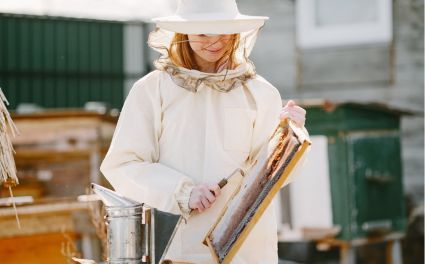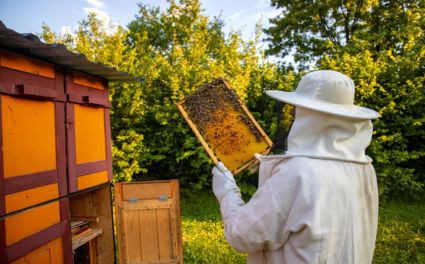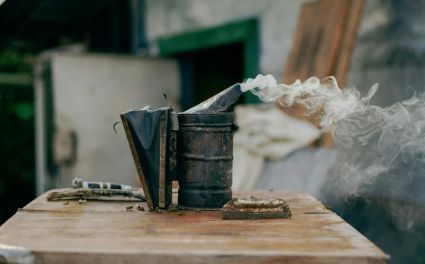Beekeeping isn’t a one-size-fits-all hobby. Just as bees adapt to their environment, so too must beekeepers. Whether you’re managing hives in the chilly mountains, the dry outback, or humid coastal regions, your approach should always reflect your local conditions.
From hive placement to feeding and even your own safety gear, your choices make a significant difference in colony health and productivity. In this guide, we’ll explore climate-specific tips, seasonal strategies, and practical gear recommendations to help your colonies thrive year-round.
Why Climate-Specific Beekeeping Matters
Every beekeeper knows that weather influences nectar flow, bee behaviour, and overall hive health. But what many don’t realise is that climate-specific beekeeping can make or break your success.
Changes in temperature, rainfall, humidity, and seasonal patterns directly affect:
-
Honey production cycles – nectar flows depend on climate conditions.
-
Swarming tendencies – hot and tropical regions increase the risk of swarming.
-
Pest and disease risks – humid climates encourage mould, beetles, and fungal issues.
-
Feeding and hive maintenance – cold winters require stored or supplementary food.
By applying regional beekeeping tips, you can align your hive management with what bees naturally require in your area. Just as importantly, equipping yourself with the right protective clothing is key. Lightweight beekeeping jackets are perfect for hot regions, while full beekeeping suits provide all-round protection in busier or colder areas.

Hot Climate Beekeeping: Surviving the Heat
For beekeepers in hot and dry climates, the biggest challenge is preventing hive overheating. When colonies overheat, combs can melt, brood may die, and honey production slows. Here are some climate-wise beekeeping strategies for arid conditions:
-
Provide shade: Position hives under trees or shade covers to avoid comb collapse.
-
Water access: Bees need water to regulate hive temperature. Place shallow water sources near hives.
-
Ventilation: Use screened or ventilated bottom boards to improve airflow.
-
Careful harvesting: Remove honey during cooler hours to minimise stress.
Personal safety is just as important. In high temperatures, breathable beekeeping trousers paired with ventilated beekeeping gloves help you stay cool and comfortable while still protected from stings.
Cold Climate Beekeeping: Thriving in Winter
When winter sets in, bees cluster tightly to generate warmth. In cold climate beekeeping, your role is to support them by conserving heat and ensuring adequate food. Key strategies include:
-
Insulate hives: Use wraps or insulated boxes to help bees conserve energy.
-
Entrance control: Reduce hive entrances to prevent icy winds entering.
-
Feeding: Provide sugar syrup or fondant if nectar sources are unavailable.
-
Honey reserves: Save frames of summer honey to keep colonies strong.
In temperate climate beekeeping, winters are milder, but sudden frosts can still harm hives. Regular checks are vital. For beekeepers, protective gear such as durable beekeeping veils ensures safety during inspections, especially when bees are defensive in colder weather.
Tropical Beekeeping: Managing Hives in Humid Regions
Tropical and humid regions often bring year-round nectar flows, which is a beekeeper’s dream. However, constant warmth and moisture also increase swarming and pest pressures. To stay ahead, consider these tropical beekeeping tips:
-
Pest control: Inspect regularly for small hive beetle, wax moths, and fungal infections.
-
Swarm management: Split strong colonies to reduce crowding.
-
Moisture management: Ensure proper ventilation to prevent mould growth.
-
Hive placement: Avoid waterlogged areas by choosing spots with good drainage.
Humid regions also mean more bee activity, so protective gear matters. Families can involve younger learners with safe beekeeping kids suits, while adults can add extra beekeeping ankle protection to safeguard against bees that crawl upwards.
Seasonal Beekeeping Practices Across Climates
Regardless of where you live, bees respond strongly to seasonal changes. Adopting seasonal beekeeping practices ensures that your colonies are always well-prepared:
-
Spring: Expand colonies, inspect regularly, and add supers before nectar flows peak.
-
Summer: Provide shade and water in hot regions; focus on swarm control in the tropics.
-
Autumn: Prepare hives for winter by consolidating food reserves.
-
Winter: Reduce hive entrances, insulate, and feed where necessary.
These weather-wise beekeeping strategies make your colonies resilient, productive, and less vulnerable to seasonal stress. And with gear from OZ Armour, including jackets, gloves, suits, and veils, you can work year-round with confidence.
Practical Climate-Wise Beekeeping Strategies
Beyond the basics, successful beekeeping often comes down to small adjustments that match your climate. Here are some tried-and-true methods:
-
Choose the right hive material: Wooden hives like pine work well in temperate zones, while insulated boxes are ideal for colder regions.
-
Modify equipment: Use entrance reducers, hive wraps, or screened bases depending on conditions.
-
Study local blooms: Knowing your regional flowering calendar helps you predict nectar flows.
-
Connect with locals: Networking with nearby beekeepers can provide valuable regional beekeeping tips specific to your area.
Remember, beekeeping is about balance: caring for your bees while also protecting yourself. Whether you prefer a lightweight jacket for summer or a full protective suit for colder months, beekeeping suits and accessories from OZ Armour offer trusted protection.

Beekeeping Gear for Every Climate
No matter your region, reliable protective clothing is essential for safe hive management. At OZ Armour, you’ll find a complete range of gear tailored to every climate and season:
-
Beekeeping Jackets – breathable protection for hot climates.
-
Beekeeping Gloves – keep hands safe while handling hives.
-
Beekeeping Veils – shield your face and neck from stings.
-
Beekeeping Trousers – flexible comfort for warmer days.
-
Beekeeping Suits – full-body protection for maximum safety.
-
Beekeeping Kids Suits – designed for young beekeepers in training.
-
Beekeeping Ankle Protection – extra coverage against bees crawling up trousers.
Each piece is designed with comfort, durability, and climate in mind, making them a must-have for every beekeeper.
Conclusion
From hot climate beekeeping in the outback to managing hives in damp coastal regions, the key to success is adaptability. By following these climate-specific tips and tailoring your practices to your environment, you’ll foster healthier colonies, reduce losses, and increase honey yields.
With the right protective gear from OZ Armour, including jackets, gloves, suits, and veils, you can stay safe while giving your bees the care they deserve.
Want to dive deeper? Read more blogs about beekeeping and discover expert advice, seasonal strategies, and product guides to level up your beekeeping journey.
Stay weather-wise, and your bees will reward you with a thriving hive—no matter the season.




